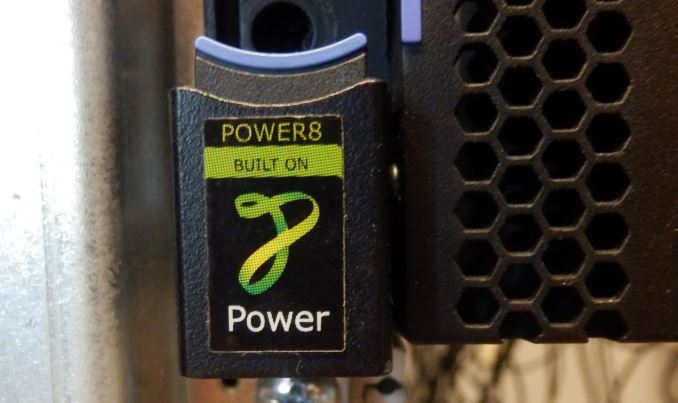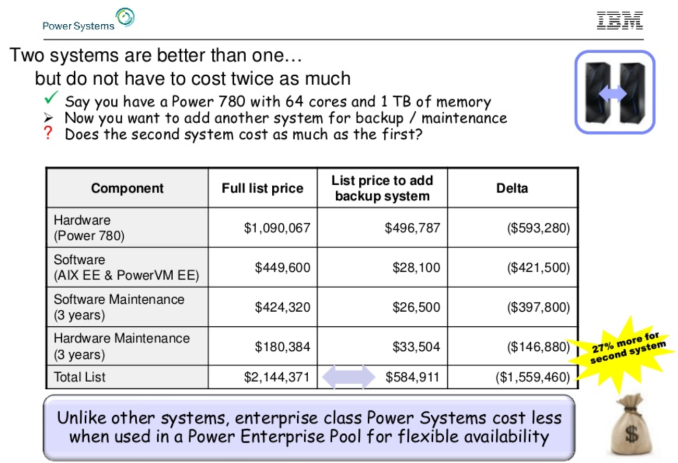The IBM POWER8 Review: Challenging the Intel Xeon
by Johan De Gelas on November 6, 2015 8:00 AM EST- Posted in
- IT Computing
- CPUs
- Enterprise
- Enterprise CPUs
- IBM
- POWER
- POWER8

Five years. That is how much time has passed since we have seen an affordable server processor that could keep up with or even beat Intel's best Xeons. These days no less than 95% of the server CPUs shipped are Intel Xeons. A few years ago, it looked like ARM servers were going to shake up the market this year, but to cut a long story short, it looks like the IBM POWER8 chip is probably the only viable alternative for the time being.
That was also noticeable in our Xeon E7 review, which was much more popular than we ever hoped. One of the reasons was the inclusion of a few IBM POWER8 benchmarks. We admit that the article was however incomplete: the POWER8 development machine we tested was a virtual machine with only 1 core, 8 threads and 2 GB of RAM, which is not enough to do any thorough server testing.
After seeing the reader interest in POWER8 in that previous article, we decided to investigate the matter further. To that end we met with Franz Bourlet, an enthusiastic technical sales engineer at IBM and he made sure we got access to an IBM S822L server. Thanks to Franz and the good people of Arrow Enterprise Computing Solutions, Arrow was able to lend us an IBM S822L server for our testing.
A Real Alternative?
Some of you may argue that the POWER based servers have been around for years now. But the slide below illustrates what we typically associated IBM's POWER range with:
Proudly, the IBM sales team states that you can save 1.5 million dollars after you have paid them 2 million dollars for your high-end 780 system. There is definitely a market for such hugely expensive and robust server systems as high end RISC machines are good for about 50,000 clients. But frankly for most of us, those systems are nothing more than an expensive curiosity.
Availability can be handled by software and most of us are looking/forced to reduce our capital expenses rather than increase them. We want fast, "reliable enough" servers at low costs that are easy to service. And that is exactly the reason why the single and dual sockets Xeon servers have been so popular the past decade. Can an IBM POWER server be a real alternative to the typical Xeon E5 server? The short but vague answer: a lot has changed in the past years and months. So yes, maybe.











146 Comments
View All Comments
JohanAnandtech - Saturday, November 7, 2015 - link
suggestions on how to to do this? OpenSSL 1.02 will support the build in crypto accelerator, but I am not sure on how I would be able to see if the crypto code uses VMX.SarahKerrigan - Monday, November 9, 2015 - link
Compile with -qreport in XL C/C++.Oxford Guy - Saturday, November 7, 2015 - link
Typo on page 2:The resuls are that Google is supporting the efforts and Rackspace has even build their own OpenPOWER server called "Barreleye".
Ryan Smith - Saturday, November 7, 2015 - link
Thanks.iwod - Saturday, November 7, 2015 - link
In terms of 100, POWER Software Ecosystem manage to scale from 10 to 20, so that is a 100% increase but still very very low. Will we see POWER CPU / Server that is cheap enough to compete with Xeon E3 / E5, where most of the volume are? Compared to E7 is like comparing Server CPU for the 10% of the market.Intel will be moving to 14nm E7, I don't see anyone making POWER CPU at 14nm anytime soon.
Intel DC business are growing, and it desperately need a competitor, such as POWER to combat E7 and AMD Zen from the bottom.
Frenetic Pony - Saturday, November 7, 2015 - link
Nice review! It just confirms my question however of "What does IBM do?" Seriously, what do they do anymore? All I see are headlines for things that never come out as actual products. Their servers suck up too much power per watt, they don't have their own semi conductor foundries, their semi conductor research seems like a bunch of useless paper tiger stuff, their much vaunted AI is better at playing Jeapordy than seemingly any real world use.Countdown to complete IBM bankruptcy/spinoff/selloff is closer than ever.
ws3 - Saturday, November 7, 2015 - link
Since the dawn of computing, IBM has been in the business of providing solutions, rather than merely hardware. When you buy IBM you pay a huge amount of money, and what you get for that is support, with some hardware thrown in.Obviously this only appeals to wealthy customers who don't have or don't want to have an internal support organization that can duplicate what IBM offers. It seems to me that the number of such customers is decreasing over time, but as long as the US government is around, IBM will have at least one customer.
xype - Sunday, November 8, 2015 - link
They make 2-5 Billion dollars of profit per quarter. "Countdown to complete IBM bankruptcy/spinoff/selloff is closer than ever." my ass.PowerTrumps - Sunday, November 8, 2015 - link
Pretty fair and even handed review; don't agree with it all and definitely feel there is room to learn and improve. Btw, full disclosure, I am a System Architect focusing on Power technology for a Business Partner.With regard to compilers I would suggest IBM's SDK for Linux on Power & Advanced Tool Chain (ATC) provide development tools and open source optimized dev stack (ie gcc) for POWER8. Details at: https://www-304.ibm.com/webapp/set2/sas/f/lopdiags... and https://www.ibm.com/developerworks/community/wikis...
MySQL is definitely relevant but with the new Linux distro's packaging MariaDB in place of MySQL I would have liked to see an Intel vs Power comparison with this MySQL alternative. MariaDB just announced v10.1 is delivering over 1M queries per second on POWER8. https://blog.mariadb.org/10-1-mio-qps/
A commenter asked about Spark with POWER8. This blog discusses how it performs vs Intel. https://www.ibm.com/developerworks/community/blogs...
In addition to the commercial benchmarks often quoted such as SPEC, SAP and TPC like this SAP HANA result with SUSE on POWER8 ; SAP BW-EML (ie HANA) shows tremendous scaling with POWER8. http://www.smartercomputingblog.com/power-systems/... many of the ISV's have produced their own. I have seen results for PostgreSQL, STAC (http://financial.mcobject.com/press-release-novemb... Redis Labs, etc.
Benchmarks are great, all vendors do them and most people realize you should take them with a grain of salt. One benefit of Power servers when using PowerVM, its native firmware based hypervisor is that it delivers tremendous compute efficiency to VM's. On paper things like TDP seem higher for Power vs Intel (especially E5_v3 chips) but when Power servers deliver consolidation ratio's with 2-4X (and greater) more VM's per core the TCA & TCO get real interesting. One person commented how SAP on Power would blow out a budget. It does just the opposite because how you can run in a Tier-2 architecture obtaining intra-server VM to VM efficiencies, compute efficiencies with fewer cores & servers which impacts everything in the datacenter. Add in increased reliability & serviceability features and you touch the servers less which means your business is running longer.
And for more details on the open platform or those based on the OpenPOWER derivative using the "LC" designator such as S822LC in contrast to the S822L used as the focus in this article. http://www.smartercomputingblog.com/power-systems/... and http://businesspartnervoices.com/ibm-power-systems...
JohanAnandtech - Sunday, November 8, 2015 - link
Great feedback. We hope to get access to another POWER8(+) server and build further upon our existing knowledge. We have real world experience with Spark, so it is definitely on the list. The blog you linked seems to have used specific SPARK optimization for POWER, but the x86 reference system looks a bit "neglected". A real independent test would be very valuable there. The interesting part of Spark is that a good benchmark would be also very relevant for the real world as peak performance is one of the most important aspects of Spark, in contrast with databases where maximum performance is only a very small part of the experience.About MySQL, people have pointed out that the 5.7 version seems to scale a lot better, so that is together with MariaDB also on my "to test" list. Redis does not seem relevant for this kind of machine, it is single-threaded, almost impossible to test 160 instances.
The virtualization part is indeed one of the most interesting parts, but it is a benchmarking nightmare. You got to keep response times at more or less the same levels while loading the machine with more and more VMs. We did that kind of testing until 2 years ago on x86, but it was very time consuming and we had a deep understanding on how vSphere worked. Building that kind of knowledge on PowerVM might be beyond our manpower and time :-).